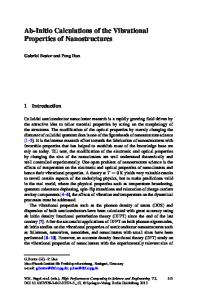Ab Initio Calculations of Ordered Intermetallic Phase Equilibria
- PDF / 1,319,082 Bytes
- 13 Pages / 420.48 x 639 pts Page_size
- 89 Downloads / 898 Views
AB INITIO CALCULATIONS OF ORDERED INTERMETALLIC PHASE EQUILIBRIA M. SLUITER*, D. DE FONTAINE*, X.Q. GUOt, R. PODLOUCKYt§ AND AJ. FREEMANt *University of California, Dept. of Materials Science, Berkeley, CA 94720 tNorthwestem University, Dept. of Physics, Evanston, 1160207 §University of Vienna, Inst. for Physical Chemistry, A-1090 Vienna, Austria
ABSTRACT General procedures for computing alloy phase equilibria from ab initio electronic structure calculations are reviewed and applied to the Al-Li phase diagram. Free energies were calculated by the cluster variationm.method (CVM) in the tetrahedron approximation for the fcc and bcc lattices and ordered superstructures. Input was provided by first principles FLAPW calculations. The computed phase diagram for both stable and metastable structures agrees remarkably well with the experimental one. INTRODUCTION The exciting possibility now exists of deriving phase diagrams virtually from first principles. There is value in determining even known phase diagrams by theoretical means alone since, once reasonable agreement has been achieved, correct thermodynamic functions are available and predictions can be made concerning equilibrium of stable and metastable phases, and properties can be predicted. Furthermore, a fundamental understanding of the underlying physics of the phase relations can be gained. The practical value of the undertaking is further enhanced when calculated binary phase equilibria are extended to include ternary, quaternary,...additions. It then becomes possible, in principle, to predict which elements are likely to stabilize which phases and computer-aided alloy design, or, in the words of Pettifor [1 ], "Quantum Engineering" becomes a distinct possibility. Theory has made great strides in the last ten years or so in three quite distinct areas: (a) first principles total energy calculations of pure crystals and of simple stoichiometric compounds can now be performed very accurately thanks to density functional theory, (b) effective pair and cluster interactions (EPI, ECI) can now be calculated by the Gautier-Ducastelle [2] generalized perturbation method (GPM), having been implemented on tight-binding (TB) and KKR-CPA codes; and (c) a reliable statistical thermodynamical model has been developed to calculate realistic temperature-composition diagrams. Let us dwell on this latter point. Until fairly recently, the standard free energy functions used in phase diagram calculations were the mean field, Gorsky-Bragg-Williams, regular of subregular solution models, method of concentration waves, or zeroth approximation;all of these methods are basically equivalent. In addition to being numerically inaccurate - transition temperatures can be off by 100% or more - these models predict the wrong phase diagram topology for fcc-based ordering systems and neglect short range order. These deficiencies can be remedied by use of the cluster variation method (CVM) [3], which was applied for the first time to phase diagram calculations by Van Baal [4] and by Kikuchi and
Data Loading...










